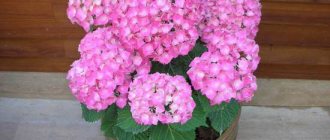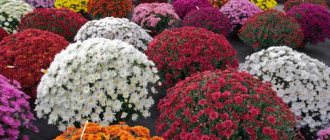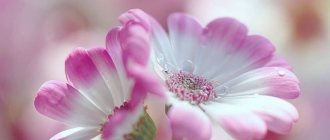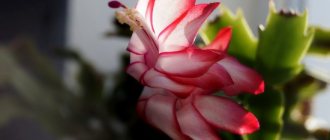Author: Elena N. https://floristics.info/ru/index.php?option=com_contact&view=contact&id=19 Category: Houseplants Published: February 22, 2019Last edits: June 01, 2021
- Reproduction methods
- Nephrolepis exaltata
The plant nephrolepis (lat. Nephrolepis) belongs to the genus of ferns of the Lomariopsis family; in some classifications it is classified as a member of the Davalliaceae family. The Latin name is derived from the Greek words “nephros” and “lepis”, meaning “bud” and “scale” in translation and containing a hint of the shape of the veil. About 30 species of nephrolepis grow in nature, distributed throughout the world, but the homeland of the nephrolepis plant is the shady forests of the tropics of Africa, America, Australia and Southeast Asia. In culture, nephrolepis fern is used as a potted or hanging plant to decorate interiors - in addition to being very beautiful, nephrolepis fern perfectly purifies the air.
Planting and caring for nephrolepis
- Flowering: does not bloom.
- Lighting: diffused light (near the window, as well as on the northern, western or eastern windowsill). The plant requires 14-16 hours of daylight.
- Temperature: during the growing season – 20-24 ˚C, during the dormant period – about 15 ˚C.
- Watering: the higher the temperature in the room, the more often and more abundantly you need to water. There is only one principle: the substrate is moistened as the top layer of soil in the pot dries.
- Humidity: high. Frequent spraying, periodic showers and keeping on a tray with wet pebbles are recommended.
- Fertilizing: from March to September 3-4 times a month with complex fertilizers for decorative deciduous plants. When wintering in a warm room, one feeding per month is sufficient.
- Dormant period: from October to February.
- Transplantation: young plants are replanted annually, adults - once every 2-3 years.
- Reproduction: vegetative only: suckers, shoots and dividing the bush.
- Pests: aphids, whiteflies, spider mites, rootbugs and scale insects.
- Diseases: loss of decorativeness due to improper care and dry air.
Read more about growing nephrolepis below.
Nephrolepis biserrata
This is a fairly large perennial plant. Its leaves are hard and shiny, semi-erect or arched, rich green in color with wavy edges, up to 2.5 meters long. Since the plant is tall, it needs a high room and special care; it is most often grown in public institutions, but not in residential premises. The plant is whimsical; with proper care and growing conditions, the perennial looks very decorative and attracts the eye.
Botanical description
Nephrolepis flower is a herbaceous plant, epiphytic or terrestrial, with a short rhizome, a rosette of light green, short-petioled pinnately compound leaves up to 70 cm long, consisting of lanceolate, serrate-crenate along the edge of segments up to 5 cm long, on the lower side of which on both sides the midrib contains round sori. With age, the leaves turn yellow and fall off. Leafless shoots, covered with scales and easily rooting, extend from the rhizome.
Nephrolepis cordifolia
This is an ornamental plant that grows well indoors. It is a deciduous perennial with shallow roots. On its roots, swellings often form in the form of nuts that do not have buds - these are tubers that store water and can be used for vegetative propagation. The leaves are arched, rich green in color, thick, often drooping, about 30-60 cm long and 5-6 cm wide. The leaves are versatile and formed on small petioles, up to 3 cm long and up to 1.5 cm wide, with jagged edges or whole, located close or far from each other. The popular variety Plumosaс is distinguished by its dark foliage color and gloss.
Caring for nephrolepis at home
Growing conditions
If you decide to purchase indoor nephrolepis, you first need to familiarize yourself with the conditions for its cultivation. Indoor fern nephrolepis prefers diffused light, so it would be better to place it near a window where direct sunlight does not reach.
If you prefer to keep flowers on window sills, windows of northern, western or eastern orientation are suitable for nephrolepis. However, the length of daylight hours in the plant's natural habitat is 14-16 hours, so if you want to see the house fern nephrolepis in its best form, be prepared to provide additional lighting for it. Nephrolepis is tolerant of fluorescent lamps, so it can often be seen in hotel lobbies and large office centers.
- Groups of indoor plants (part 2)
The optimal temperature regime for fern in the warm season is 20-24 ºC, but with frequent spraying of the leaves it can withstand higher temperatures. In winter, comfortable conditions for resting nephrolepis are a temperature of about 15 ºC, but the main thing is to keep the plant as far as possible from heating devices. If you do not have the opportunity to place the plant in a cool room during the dormant period, leave it in its usual place and continue spraying and watering - nephrolepis will continue to develop, although not as intensely as in the summer.
Caring for nephrolepis fern includes regular feeding of the plant with complex fertilizers for ornamental foliage plants in a concentration equal to one-fourth of that specified by the manufacturers. Fertilizing is applied approximately three to four times a month from March to September - provided there is a cool winter, the plant does not need fertilizers for the rest of the year. If the fern remains warm in winter, then you can feed Nephrolepis in winter no more than once a month.
Watering
As for watering nephrolepis, its frequency and water consumption at a time depend on the temperature in the room: the higher it is, the more frequent and abundant the watering should be. The top layer of soil in the pot should dry out between waterings. If the indoor plant nephrolepis rests in cool conditions in winter, it does not need frequent watering and large amounts of water - watering is carried out as the top layer of soil dries.
To organize a high humidity regime for a plant in the warm season, it is recommended to spray its leaves with non-cold, settled water as often as possible and it is advisable to give nephrolepis a shower at least once a month. You can keep the fern on a tray with wet pebbles or expanded clay so that the bottom of the pot does not touch the water. By the way, nephrolepis also needs to be watered with settled or filtered water at room temperature.
Transfer
Young ferns are replanted every spring, adults - once every two to three years. It is preferable to grow nephrolepis in a plastic container rather than a ceramic one - plastic retains moisture in the soil longer. Since the plant’s root system is superficial, choose a shallow, wide pot for it. Before transplanting nephrolepis, place a layer of expanded clay in the new pot so that excess water does not stagnate in the roots of the plant, then place a layer of substrate in it.
The soil for nephrolepis should be light: high-moor peat, greenhouse and coniferous soil in equal parts. It is advisable to add a little bone meal to the soil mixture in a proportion of 5 g per 1 kg of soil. If you don’t want to bother with making a soil mixture, purchase a ready-made acidic substrate for ferns in the store, although nephrolepis will also be suitable for soil for camellias, calla lilies or hydrangeas with a pH value of 4.5-5.5. When transplanting, the root collar is left above the soil surface. The transplanted plant initially needs constantly moist soil and high air humidity.
- Caring for begonia at home - difficulties
Pests and diseases
Nephrolepis at home with insufficient care is affected by whiteflies, aphids, scale insects and spider mites. You can cope with these harmful insects by treating the plant with insecticides Actellik, Aktara and similar preparations.
Sometimes readers ask why nephrolepis leaves dry out. Most often, nephrolepis dries out from insufficient or infrequent watering. If only the tips of the leaves dry out, this is a sign that the air humidity level in the room is low for the plant.
If leaves turn brown, curl, and fall off, it may be due to drafts, low temperatures, or watering with cold, chlorinated, or hard water. When dry spots appear on fern leaves, these are most likely burns from direct sunlight.
Properties of nephrolepis
It is believed that nephrolepis absorbs energy and electromagnetic radiation harmful to humans, improves immunity, instills vigor, and cleans the air of dust and harmful fumes. You can keep nephrolepis at home, placing it near the TV or next to the computer, or you can grow it in the office, and it will be in place everywhere. Psychologists say that proximity to nephrolepis reveals perseverance, perseverance and prudence in a person - precisely those qualities that we all lack, however, it should be borne in mind that tobacco smoke reduces the effect of these wonderful properties of the plant.
Problems during cultivation
- Some leaves dry out completely, but new growth is observed - a natural process of plant renewal;
- The tips of the leaves dry out when the air humidity is too low or when the soil is regularly dried out;
- Brown formations on the underside along the edges of the leaves are natural formations - sori, in which fern spores ripen;
- Nephrolepis becomes grayish-pale due to overdrying and lack of moisture in the soil;
- Yellowing of the foliage occurs if the fern suffers from an excess of light;
- Leaf fall occurs when there is excessive or, conversely, insufficient watering, or when watering with cold water. Nephrolepis can also shed foliage due to temperature changes, lack or excess of lighting.
Views: 938
Reproduction of nephrolepis
Reproduction methods
Nephrolepis reproduces by dividing the rhizome, shoots and suckers. The fact is that many varieties of this genus are sterile, and even if they form spores, they do not convey the characteristics of the mother plant. That is why nephrolepis is propagated vegetatively at home.
Dividing the bush
Usually the bush is divided in the spring, at the same time as the plant is replanted. Only large plants that have several growing points can be divided. The cuttings, each of which must have at least one growing point, are planted in a separate plastic container, watered and rooted, creating conditions of high humidity at a temperature of 15-18 ºC. However, do not expect quick success: for normal development, the divisions need to build up the root system, and this takes time.
Reproduction by offspring
Nephrolepis tendrils (leafless shoots) are taken to the side and buried in a bowl with light soil to a depth of 0.5-0.8 cm, leaving the tops above the surface. During rooting of the shoots, the soil in the bowl should be slightly moist at all times. After 10-15 days, the shoots take root, and after another time, new shoots appear. When the plants become stronger, they are separated from the mother plant and transplanted into individual containers.
- What to do if your cat eats flowers
Diseases and pests
If you properly care for nephrolepis Sonata, Vitale, Emina and other types of popular indoor ferns, you can prevent the appearance of pests and diseases.
For your information! The cause of most types of diseases is improper care.
By the appearance of the plant, you can determine what it suffers from and take timely measures to eliminate negative factors.
- If nephrolepis leaves begin to dry, the care mistake lies in improper watering. Yellow lower leaf blades with brown tips of the segments indicate an excess of moisture; leaves that turn yellow, wither and stop growing indicate a lack of water.
- If the fronds wither, curl and die, the reason may be the use of cold water, an insufficiently warm room, the presence of drafts and low humidity levels.
- If the plant fades and stops growing, it is lacking nutrients.
- If dry spots appear on the leaves, the fern has been burned due to direct sunlight.
When gray rot (fluffy plaque) appears, the foliage should be treated with fungicides (trichophyte, alirinomm-B, etc.).
Patient nephrolepis
Important! Gradually yellowing of foliage is a natural process. To maintain a beautiful appearance, it needs to be trimmed.
Pest Control
The main enemies of house ferns are spider mites, whiteflies and mealybugs.
White dots on greenery and drying foliage indicate the appearance of spider mites, the appearance of yellow spots indicates whiteflies, and white cottony coating indicates mealybugs. In the first two cases, the leaves are treated with a water-alcohol solution in a 1:1 ratio, in the last - with water and soap dissolved in it. After this, insecticides are used (fitoverm, actellik, actara, etc.).
Voluminous and miniature, smooth and fluffy, similar to palm trees and vines - house ferns can satisfy any taste. Due to the variety of varieties, nephrolepis are a popular decoration for apartments, offices and garden landscapes.
Types and varieties
Not many types of nephrolepis are grown in culture, but we will tell you about the most popular ferns.
Nephrolepis exaltata
In nature, it is an epiphyte or terrestrial herbaceous plant with a vertical rhizome, on which a rosette of large, pinnately compound light green leaves up to 70 cm long on short petioles develops. The leaves consist of lanceolate segments up to 5 cm long, serrate-cense along the edges. As they age, the leaves turn yellow and fall off. On the underside of the segments on both sides of the midrib, sori with spores mature. Scale-covered lashes (stolons) are formed on the rhizome, which easily take root. Nephrolepis sublime is native to the tropical regions of Southeast Asia.
This species has many garden forms and varieties:
- nephrolepis Roosevelt - a large fern with fronds with wavy segments sticking out in different directions;
- nephrolepis Maasa - a compact variety with wavy leaves;
- Nephrolepis Scott is also a small plant with segments curled at the edges;
- nephrolepis Green Lady is a very beautiful fern with a lush fountain of openwork wavy leaves with a pointed tip, crowning a vertical rhizome;
- Nephrolepis Emina is a low-growing compact variety with almost erect fronds with curly leaves with carved teeth along the edges;
- Nephrolepis Boston, or Nephrolepis Bostonian, is an upright growing plant that was bred in the USA and literally immediately became popular among breeders: on its basis, varieties were bred with double-, triple- and quadruple-pinnate fronds reaching a length of 120 cm, the segments of which depend on varieties can be wavy or twisted:
- nephrolepis Hills and Fluffy Raffles - ferns with double-pinnate leaves;
- Whitman's nephrolepis is a plant with triply pinnate leaves;
- nephrolepis Smith - nephrolepis with four-pinnate leaves.
Nephrolepis cordifolia
It differs from Nephrolepis sublime by swellings on underground shoots, similar to tubers, covered with silver or white scales, and also by the fact that its fronds, with a denser, sometimes tiled arrangement of rounded segments, are directed upward almost vertically. Nephrolepis cordifolia is native to subtropical forests of both hemispheres; this species has been in cultivation since 1841; it is often used to make bouquets.
Nephrolepis biserrata
Originally from Central America. It is distinguished by long leaves, sometimes reaching 2-2.5 m in length in greenhouse conditions. Nephrolepis ensiform can only be grown in large rooms.
Nephrolepis curly or curly
This group of plants was named so because their leaves are very similar to lace. The species was developed thanks to Nephrolepis sublime. There are only a few representatives of the species whose leaves are wavy or curled. The plant is short in stature and is particularly decorative due to its openwork leaves.
Popular varieties of nephrolepis curly:
- "Teddy Junior" The leaves are wavy.
- "Roosveltii". The leaves are wavy.
- "Maassii". The leaves are wavy.
- "Scottii" The leaves are curled.
Nephrolepis - signs
Fern nephrolepis is a very popular plant, maybe that’s why there are legends about it, it is the central character of many superstitions and signs. Some talk about the positive effect of the plant on human health and the environment, while others attribute witchcraft properties to nephrolepis that can influence a person’s fate. An ancient legend says that none of the people could see the fern flower, because on the night of Ivan Kupala, when it blooms, it is plucked by an invisible hand, and all sorts of mystical horrors await those who go into the forest in search of this flower.
Another belief says that the fern scares away evil spirits, protects the house from evil witchcraft and black magic, preventing the evil eye or damage from being cast on the owners. They also say that fern brings success in business, has a positive effect on material well-being - it attracts money into the house, protects its owners from irrational actions and impulsive spending. It is said that there have been cases of sudden enrichment that are associated with the presence of ferns in the house.
If people of different temperaments live in a house, fern helps to establish good harmonious relationships between them. Under the influence of his aura, aggressive manifestations of people’s character are softened, temper goes away, and confrontation is smoothed out. This is probably why nephrolepis is called the “golden mean” plant.
Which of the stories about ferns is true and which is fiction, everyone decides for themselves. However, I must say that I personally have not felt any negative effects of indoor nephrolepis on my life. For me, nephrolepis is a non-capricious, spectacular plant that brings beauty to the house, purifies the air in the apartment and creates a cozy atmosphere. And let me finally give you some advice: do not be afraid to grow nephrolepis in your home and do not listen to those who themselves live with fears and prejudices.
Nephrolepis exaltata sonata
This is an indoor plant that is often grown as an hanging crop in a hanging flowerpot or flowerpot. Light green leaves densely cover the plant. The plant is very useful because... its greens help purify the air and fight bacteria and harmful microelements. The plant is low-growing and very compact, feels good in ordinary pots, in lighted places and in partial shade.
There are other, less popular types of nephrolepis, for example, nephrolepis bisserata, acute, tuberose, oblierata, multiflora and pectinate.
Join our Facebook group
Basic care
An unpretentious lush flower will delight your home all year round. Some varieties require increased care. Indoor floriculture has more than two hundred groups.
Immediately after purchase
How to properly care for a house fern after purchasing? Replace the soil immediately. In stores, they are planted in an enriched soil mixture to give them a marketable appearance. It is necessary to change the soil to favorable:
- acidity up to 5 pH;
- leaf soil;
- humus;
- peat.
It is better to choose a clay or ceramic container for transplanting. Expanded clay can be used as drainage. The flower is carefully rolled over with a lump of earth and the prepared mixture is added. Without compacting the top layer. Pour in settled water at room temperature.
Accommodation
Many species are native to tropical forests. There is a lot of shade and little sunlight. However, a place that is too dark is not suitable for the plant. You need to choose one that is well lit, but without direct sunlight. The western and eastern sides will be optimal.
Adults require sufficient free space. Large flowers will not fit on the window; you will need a floor stand. In spring and summer, the flower can be taken out onto the terrace, balcony, or gazebo. Minimize sun exposure in advance.
The soil
Ferns prefer loose, ventilated soil with fallen, rotted leaves, pine needles, peat, and slightly increased acidity. You can prepare a favorable soil composition yourself:
- leafy;
- turf;
- humus;
- peat;
- coarse sand.
The ready-made soil mixture from a flower shop or prepared yourself should be loose and drain well.
Temperature
Most indoor ferns are suitable for temperatures no higher than twenty-two degrees and no lower than fifteen. Some resistant varieties develop favorably at twelve degrees, but for heat-loving varieties it should not be lower than eighteen. Sudden temperature changes and drafts adversely affect them.
Watering and spraying
Fern is a moisture-loving plant that needs regular, abundant watering. It is necessary to avoid stagnation of water, ensuring that excess moisture drains away. Water with settled, melted, soft or boiled water at room temperature. Excessive moistening of a dried flower is detrimental to the root system. This will cause rot. Regular misting maintains moisture conditions and prevents pests. It is better to carry out the procedure in the morning. In hot weather, you can repeat this two to three times.
Feeding and fertilizer
Requires regular application of mineral and organic fertilizers, especially for fast-growing representatives. Proper alternation of feeding: add minerals every two weeks, and organic matter every fourteen days.
The rest period begins at the end of October and ends in February. At this time, it is worth stopping feeding and reducing watering.
Transfer
They grow quickly, filling the pot with roots. Young specimens are replanted annually in the spring, mature ones - every two to three years:
- Choose a pot six centimeters wider than the previous one and the same amount higher.
- Lay out drainage with a top layer of moss.
- Move along with the earthen lump, after lightly crumbling and removing dead parts.
- Add substrate.
- Do not bury the root tip completely into the soil.
Types of ferns for home cultivation
This evergreen plant does not care about living conditions - it thrives in swamps and meadows, as well as in shady forests in tropical climates. Some varieties can only live indoors, while others thrive in low temperatures, surviving the winter months in the ground.
Most species of shrubs have dissected-pinnate leaves, but some varieties are distinguished by fused leaves, which can be of various shapes and specific sizes.
There are a lot of legends where on the night of Ivan Kupala people go to look for and collect flowers of a mysterious fern. But no matter how hard they try to find the treasured color, it simply does not exist in nature. The fern does not produce color, it does not produce seeds or fruits, and the swelling of scales on the underside of the leaf plate is spores, which are how the marvelous plant reproduces.
There are not many varieties of ferns that can be grown at home. Among them are the most popular varieties:
It requires partial shade and a humid climate. Such varieties of ferns from this line as bulbous, nesting and viviparous are suitable for home cultivation.
It has the ability to reach a crown of up to 1 m in height. In this case, the rigid leaf plates begin to resemble palm leaves in appearance. The Brazilian variety or Humpbacked Blechnum are suitable for cultivation.
The stems of the shrub are graceful, fine in structure, but distinguished by their strength. For rapid growth of the bush, shade, high humidity and optimal air temperature will be required. The best option for growing this variety would be a greenhouse or a special greenhouse. Among the species of this variety, the predominant ones are Tender, Venus Hair, Radi and Fine Hair.
Refuses to grow if other varieties of flora are nearby
It requires a lot of space and increased attention. The fronds of the plant have a strongly dissected appearance, due to which the shrub gets an interesting openwork effect
It has a thick root system. Thanks to this, the plant was popularly nicknamed hare's or squirrel's feet.
The foliage of the bush is dissected, the rhizomes are located on the surface, which gives the appearance of a creeping plant. Feels great in rooms with dry air.
In favorable conditions it reaches 3 m. It is grown for decorating large rooms.
The owner of large, bladed leaf plates. In appearance it resembles huge deer antlers.
Therefore, before planting a plant in your garden or in a pot, you should choose one of the varieties. Each type is distinguished by its originality and elegance of leaf plates.











